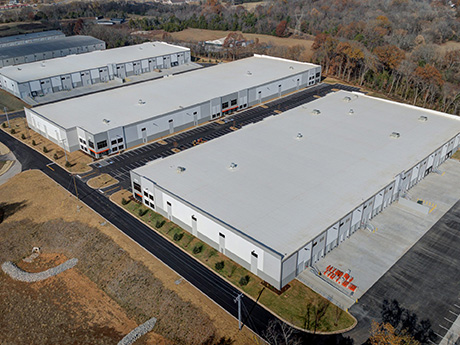By Jack Armstrong and Joanna Paszek of CBRE
The Nashville industrial market remained strong through 2023 despite macroeconomic pressures, fueled by persistent occupier demand and limited availabilities. Occupiers were active in the market with mostly sub-100,000-square-foot requirements, making it vital for owners and developers to consider size segment trends and supply the market based on varying occupier needs.

The logistical advantage of Nashville’s geographic location continues to attract occupiers and investors to the market. Three major interstates intersect through the city, and companies can reach 72 percent of the U.S. population within two-day ground delivery. A consistent average of 100 new residents daily and waves of new-to-market companies helped promote a swift post-pandemic economic recovery and illustrate the market’s resilience.
An increased presence of electric vehicle (EV) companies is paving the way for significant infrastructure upgrades, bringing high-paying jobs and growing supply-chain demand to support their product distribution. Economic incentives like Tennessee’s FastTrack Program grants for job training and infrastructure development, job tax credits and sales tax exemptions have attracted roughly 2,500 jobs and $2.8 billion of capital investment by EV-related operations to Middle Tennessee since 2020.
Together, Nashville’s pro-business environment and status as a place people want to live and raise families will attract both industry and top talent to the region for years to come.
Occupier trends
In recent years, occupier needs for sub-100,000-square-foot availabilities dominated activity, proven by a 79 percent share of deals signed in 2023. However, the current construction pipeline doesn’t account for single-tenant users below 100,000 square feet, which may require landlords to consider demising larger spaces for multiple users.

Shallow bay product is in high demand and should continue for the foreseeable future. Big-box deals above 200,000 square feet also grew annually from 15 to 19 transactions. Occupier size trends are spreading further across size segments, causing developers and owners to adapt their properties to various needs.
Shallow bay availabilities commanded significantly higher asking rents in Nashville, averaging $10.45 per square foot in 2023 due to higher construction costs to build and tenant improvement (TI) allowances per square foot. Nashville’s average triple-net asking lease rate climbed to $7.84 per square foot as vacancy tightened and demand remained strong. High-dollar new construction availabilities bolstered rent growth, a trend that should continue as existing lower-cost options lease up and are outweighed by more expensive availabilities.
Inventory expansion
To meet occupier demand, record levels of new construction deliveries expanded Nashville’s industrial inventory from 184 million square feet to 218 million square feet over the past five years. I-840, a high-demand and growing submarket of Nashville, nearly doubled its inventory while the largest submarket, Interchange City, grew by 25 percent. These two submarkets alone added 27.3 million square feet to the local supply.
In 2023, 8.8 million square feet of new development projects delivered. Panattoni’s completion of Buildings 10, 11 and 12 at Speedway Industrial Park in the I-840 submarket were the largest additions of any park at 1.8 million square feet combined. They were 86 percent preleased or sold to Webstaurant, LaserShip and Ferguson. A limited supply of 11 newly constructed buildings left roughly 3 million square feet available and vacant, fit for bulk occupiers, unless the spaces are demised.
There is currently more than 10 million square feet of industrial product under construction, concentrated in the 100,000- to 500,000-square-foot range in high-growth or under-supplied submarkets like I-840 and the Northeast/I-65N Corridor. City View, a nine-building development by Prologis with facilities ranging from 132,000 to 329,000 square feet, will relieve low warehouse supply in the MetroCenter/Cockrill Bend submarket and serve a wide range of occupier sizes.
Higher vacancy compression in particular size segments is signaling the need for additional development, yet construction costs and high interest rates constrain the ability to break ground for some groups. The highest annual vacancy compression occurred at properties in the 50,000- to 99,999-square-foot and 200,000- to 499,999-square-foot size ranges, consistent with leasing activity trends.
While construction costs and interest rates remain high, some projects are focused on site work and infrastructure build-out to lure build-to-suit opportunities amid the capital markets’ recent hesitancy toward speculative developments. With less preleasing activity and more deal executions closer to or post-completion, occupiers need speculative availabilities for companies seeking readily occupiable space.
There is consistent active prospective tenant activity on par with historical levels. Once those leases execute, vacancy will compress further, notwithstanding additional new supply coming on line.
Future outlook
The rate of development completions will be affected by challenges of land entitlements, potential neighborhood opposition and macroeconomic uncertainties. There is a great deal of capital sitting on the sidelines waiting for the economic climate to improve and trigger the ability to deploy into these developments.
Despite these challenges, Nashville is well-poised to sustain its growth path. Throughout 2024, steady occupier demand, investor activity and new construction starts should encourage continued rent growth and vacancy compression while positive net absorption outweighs new supply.
The fundamentals show that the market needs more inventory to satiate this demand, which is a positive indicator for Nashville looking ahead.
— By Jack Armstrong, First Vice President, and Joanna Paszek, Field Research Analyst, CBRE. The article was originally published in the February 2024 issue of Southeast Real Estate Business.


